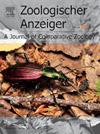Definition of the pygmy grasshopper subfamily Criotettiginae (Orthoptera: Tetrigidae) with a preliminary catalogue of genera
IF 1.5
3区 生物学
Q2 ZOOLOGY
引用次数: 0
Abstract
A new pygmy grasshopper subfamily is established, Criotettiginae Kevan, 1966 subfam. nov. to include 24 genera—Acanthalobus Hancock, 1904, Afrocriotettix Günther, 1938b, Amphinotulus Günther, 1939, Apterotettix Hancock, 1904, Aryalidonta Subedi & Kasalo, 2023, Bolivaritettix Günther, 1939, Bolotettix Hancock, 1907, Cotysoides Zheng & Jiang, 2000, Criotettix Bolívar, 1887, Dasyleurotettix Rehn, 1904, Eucriotettix Hebard, 1930, Hyboella Hancock, 1915, Indomiriatra Tinkham, 1939, Loxilobus Hancock, 1904, Miriatroides Zheng & Jiang, 2002, Probolotettix Günther, 1939, Rhopalina Tinkham, 1939, Rostella Hancock, 1913, Spadotettix Hancock, 1910, Syzygotettix Günther, 1938b, Tettitelum Hancock, 1915 (tentative assignment), Thoradonta Hancock, 1909, Timoritettix Günther, 1971 and Yunnantettix Zheng, 1995. The new subfamily is defined based on clear morphological apomorphies and previously published phylogenetic data evidencing a well-supported clade. Members of this subfamily have until now been scattered across the Tetrigidae subfamilies—Cladonotinae (Yunnantettix), Metrodorinae (Cotysoides, Hyboella, Indomiriatra, Miriatroides, Rostella, and Timoritettix), and Tetriginae (Afrocriotettix)—or have been without subfamily assignment (Bolotettix, Probolotettix, Syzygotettix, Tettitelum). Criotettiginae consists of tribes Criotettigini and Thoradontini, the monophyly of which has to be tested. Ten new combinations are proposed—(1) Acanthalobus afghanus (Čejchan, 1969) comb. nov. for Criotettix afghanus (2) Acanthalobus gidhavensis (Gupta & Chandra, 2018) comb. nov. for Criotettix gidhavensis; (3) Acanthalobus gariyabandicus (Gupta & Chandra, 2018) comb. nov. for Criotettix gariyabandicus; (4) Acanthalobus latifrons (Hebard, 1930) comb. nov. for Criotettix latifrons; (5) Aryalidonta subulata (Bolívar, 1887) comb. nov. for Criotettix subulatus; (6) Loxilobus convexus (Deng, Zheng & Wei, 2007) comb. nov. for Mazarredia convexa, (7) Loxilobus convexaoides (Deng & Zheng, 2015) comb. nov. for Mazarredia convexaoides; (8) Loxilobus shiwanshanensis (Deng & Zheng, 2015) comb. nov. of Mazarredia shiwanshanensis; (9) Loxilobus neesoon (Tan et Storozhenko, 2018) comb. nov. for Eucriotettix neesoon; (10) Loxilobus simulans (Tan et Storozhenko, 2017) for Eucriotettix simulans; and (11) Yunnantettix yunnanensis (Zheng, 1993) comb. nov. for Paramphinotus yunnanensis. Acanthalobus curticornis Hancock, 1915 comb. rev. has been restored to its original combination, having previously been placed in the genus Criotettix. Many members of Mazarredia from China are in fact species of the genus Loxilobus, and this problem needs to be solved in the future. Two new synonyms are proposed—(1) Paramphinotus Zheng, 2004 syn. nov. is synonymized with Yunnantettix; while (2) Thoradonta dentata Hancock, 1909 syn. nov. is synonymized with Thoradonta nodulosa (Stål, 1861). Finally, Acanthalobus inornatus and A. curticornis are reported for the first time from Nepal.
标题侏儒蚱蜢亚科定义(直翅目:蚱科)及初步属目录
建立了一个新的侏儒蚱蜢亚科,Criotettiginae Kevan, 1966 subfam。11月包括24个属:棘科植物汉考克,1904年;非洲棘科植物 nther, 1938年;两栖动物 nther, 1939年;Kasalo, 2023, Bolivaritettix gnther, 1939, Bolotettix Hancock, 1907,子叶亚目郑&;Jiang, 2000, Criotettix Bolívar, 1887, Dasyleurotettix Rehn, 1904, eucriotetix Hebard, 1930, Hyboella Hancock, 1915, Indomiriatra Tinkham, 1939, Loxilobus Hancock, 1904, Miriatroides Zheng &;Jiang, 2002, Probolotettix g, 1939, Rhopalina Tinkham, 1939, Rostella Hancock, 1913, spadotetix Hancock, 1910, Syzygotettix g, 19838b, Tettitelum Hancock, 1915(暂定),Thoradonta Hancock, 1909, timorittetix g, 1971和Yunnantettix Zheng, 1995。新的亚科是基于清晰的形态学特征和先前发表的系统发育数据来定义的,这些数据证明了一个得到良好支持的进化支。到目前为止,这个亚科的成员已经分散在蚱科亚科中——cladonotinae (yunnantetix)、Metrodorinae (Cotysoides、Hyboella、Indomiriatra、Miriatroides、Rostella和Timoritettix)和Tetriginae (afrocriotetix)——或者没有亚科分配(bolotetix、probolotetix、syzygotetix、Tettitelum)。Criotettiginae由Criotettigini和Thoradontini部落组成,其单一性有待检验。提出了10种新的组合——(1)棘alobus afghanus (Čejchan, 1969)梳子。11 . for criotetix afghanus (2) Acanthalobus gidhavensis (Gupta &;钱德拉,2018)。11月为Criotettix gidhavensis;(3)棘alobus gariyabandicus (Gupta &;钱德拉,2018)。11月为criotetix gariyabandicus;(4) Acanthalobus latifrons (Hebard, 1930)梳子。11 .为criotetitix latifrons;(5) Aryalidonta subulata (Bolívar, 1887)梳子。11月为小冠凤梨;(6)凸叶(邓,郑,等);魏,2007)梳。(7)凸叶Loxilobus convexaoides(邓& &;郑,2015)梳。11月为马扎雷迪亚(Mazarredia convexaoides);(8)石万山Loxilobus shiwanshanensis (Deng &;郑,2015)梳。石万山马扎兰11月;(9) Loxilobus neessoon (Tan et Storozhenko, 2018)梳子。11月为欧几里亚松;(10) Loxilobus simulans (Tan et Storozhenko, 2017)用于Eucriotettix simulans;(11) yunnantetix yunnanensis (Zheng, 1993)梳子。11 .云南旁棘虫。汉考克,1915年梳子。rev.已恢复到原来的组合,以前被放在criotetitix属。来自中国的马扎瑞亚的许多成员实际上是Loxilobus属的物种,这一问题需要在未来得到解决。(1)将Paramphinotus Zheng, 2004 syn. 11 .与yunnantetix同义;(2) Thoradonta dentata Hancock, 1909 syn11 .与Thoradonta nodlosa同义(stamatl, 1861)。最后,在尼泊尔首次报道了棘alobus inornatus和A. curticornis。
本文章由计算机程序翻译,如有差异,请以英文原文为准。
求助全文
约1分钟内获得全文
求助全文
来源期刊

Zoologischer Anzeiger
生物-动物学
CiteScore
2.80
自引率
7.10%
发文量
75
审稿时长
>12 weeks
期刊介绍:
Zoologischer Anzeiger - A Journal of Comparative Zoology is devoted to comparative zoology with a special emphasis on morphology, systematics, biogeography, and evolutionary biology targeting all metazoans, both modern and extinct. We also consider taxonomic submissions addressing a broader systematic and/or evolutionary context. The overall aim of the journal is to contribute to our understanding of the organismic world from an evolutionary perspective.
The journal Zoologischer Anzeiger invites suggestions for special issues. Interested parties may contact one of the editors.
 求助内容:
求助内容: 应助结果提醒方式:
应助结果提醒方式:


